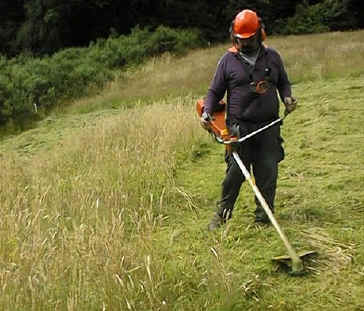The Woodland Education Centre
Heathland Project Report
Report Introduction Contents Summary
The Effects of Management - Brushcutting

a) General
i) Grasses
The main effect of brushcutting at present seems to be the encouragement of the spread of Yorkshire Fog (Holcus lanatus). The vegetation of the project site has always been dominated by grasses, mainly species of Bent (Agrostis spp.) which are characteristic of acid soils and Yorkshire Fog. Initially, the Bents were dominant over the site, but by 1998, Yorkshire Fog had taken over as the most dominant species (Table). The percentage cover of Yorkshire Fog more than doubled from 1997 - 1998.
Changes in distribution and abundance of Yorkshire Fog over the past three years are illustrated in Figures A - C, Chart. Corresponding with the increase in % cover of Yorkshire Fog, the % cover of the Bent species is generally declining (Chart D-J). Dominance by Yorkshire Fog and Common Bent is undesirable on the project site, because it leads to an unbroken sward which does not allow for the establishment of other species. In the summer months, the grass reaches heights in excess of 1m, shading out other smaller competing species. In contrast, species such as Bristle Bent, characteristic of heathlands, forms individual tussocks which still allow for the establishment of other heath species in between plants.
The relationship between the increasing dominance of Yorkshire Fog and cutting is shown by the fact that the only areas in which Yorkshire Fog is not dominant are those which are not cut (sections 5 and 9), together with section 7, where grasses were initially controlled by the use of Kerb granules (Table). Management summary
Brushcutting is non-selective and reduces all vegetation to ground level at regular intervals. This eliminates competition from species which would grow taller than the grass given time, such as Gorse, Heather and tree seedlings. If these are allowed to grow up, as in sections 5 and 9, they outcompete the Yorkshire Fog and Bents and prevent them from becoming dominant. Thus the dominant species in sections 5 and 9 include Gorse, Heather and Silver Birch (Table). While this would seem to indicate that brush cutting is unfavourable by promoting the spread of grasses, it must be remembered that in time, the tall vegetation would shade out underlying heath species. Brush cutting is therefore necessary for long-term considerations.
Continue to grass distribution on the Heathland Restoration site ![]()
| Heathland Restoration Project Report | ||||

Other Lowland
Heaths in East Devon